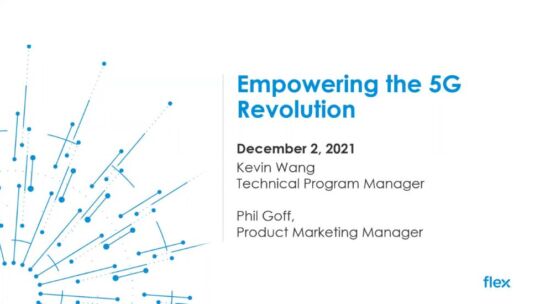
5G wireless technology brings more than just faster download speeds. It promises to permanently disrupt product design and manufacturing. 5G will reshape what it means to be competitive across industries by allowing for new use cases, business models, and products at an unprecedented pace. How will you harness 5G to deliver the next great experience to your customers?

5G will allow for massive connectivity
5G puts new applications on the table for design teams. Product brainstorm now begins by imagining solutions with low end-to-end latency. IoT devices will connect to thousands of devices at once. And thanks to greater computing capabilities, fast speeds move processing power from the product into the network. Massive connectivity and computing power will reshape how and what you make.
You must engineer intelligence into both process and product to realize the full benefits of 5G in a competitive atmosphere.
5G will require high-quality production
Whether working toward version 2.0 of an existing product or a brand-new offering, all of these enhanced capabilities begin with proper connectivity to the 5G network. Challenges will differ by 5G product and use case, but all 5G ultra-reliable and low-latency communications (URLLC) devices will need high-quality production so that they meet the reliability and latency specifications that deliver 5G benefits.
We work with companies of all sizes to develop 5G-ready products. For example, our specialists have analyzed and tested radio frequency (RF) seal solutions so that products can take advantage of 5G with reduced interference.
Edge computing will save the day for low latency
Edge computing will help new use cases achieve the velocity 5G promises. Even with a 5G rollout, communications from cloud-based applications will lag at least 10 milliseconds, negating any possibility of sub-millisecond latency, according to ReTHINK. Edge-compute resources near or on the device solve for that lag, granting IoT products increased reliability and low latency.
A partner in edge infrastructure design and manufacturing can help you reduce latency and enable new applications. We are able to design antennas for various purposes, from mobile devices to routers and from small-cell base stations to large macro units.
5G will offer new use cases for 4G
5G offers new use cases for the next iteration of current 4G products. To realize those use cases, version 2.0 of an existing product will need to account for new designs. For example, because 5G frequencies are much higher than those of 4G, adjustments in radio frequency (RF) circuit design will be necessary to achieve enough isolation between RF circuits and transmission lines.
The best performance of a product containing RF components requires careful modeling and implementation. We apply our experience in RF mechanics to design protection against interference (both emission and immunity) in base stations and other demanding RF devices. Our extensive manufacturing experience and leading market share in manufacturing radios and baseband units can then help you make that design a reality.
Product lifecycle will get shorter
The race to build new products will result in shorter product lifecycles. You must enhance every phase of product design and manufacturing to compete in a hyper-competitive market. Reference designs and a modular approach to design help to accelerate a new product’s time-to-market. 3D-printed concept models visualize your future product, while rapid-prototyping shortens the product-development cycle.
A simulated investigation allows for time, resource, and physical scaling. We use software to simulate a physical environment and help you create the best solution. When we apply that solution to the physical environment, we create and maintain a closed-loop cyber-physical system. Conditions can be varied, and outcomes validated in infinite ways, allowing for design complexity.
5G will empower smart factories
Modern manufacturing also condenses the product development process so that businesses remain agile in the face of market disruptions. The anticipated abundance of sensors and data analysis in the cloud will improve productivity, advance machine-to-machine communication and improve resources. 5G will allow smart factories to more rapidly develop highly customizable products and facilitate direct-to-consumer business models.
Low latency will speed the manufacturing process
URLLC allows for the control of production line robotics, instantaneously correcting or shutting down a malfunctioning machine. Factory workers can wear AR headsets, powered by 5G, to speed and improve the quality of inspections, troubleshoot faults, and even detect operational inefficiencies before they happen. 5G’s promise of lower latency will ultimately enable predictive maintenance, increased yield and speed, and AI-driven analyses.
We’ve embedded sensors, AI, and machine learning into the ecosystem of our solutions to not only retrieve, but also manage, data of any kind, from any source, at massive scale. We help you interact smoothly with data, ask better questions, and make better decisions.
5G will drive the future — faster
5G will create faster and more connected product design and manufacturing capabilities. A company’s ability to adapt, be creative, and overcome challenges will be the ultimate differentiator. Start by making room for connected intelligence early on during product design and carry it through to the factory floor.


